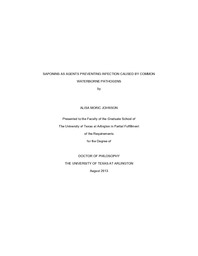
ATTENTION: The works hosted here are being migrated to a new repository that will consolidate resources, improve discoverability, and better show UTA's research impact on the global community. We will update authors as the migration progresses. Please see MavMatrix for more information.
Show simple item record
| dc.contributor.author | Johnson, Alisa Moric | en_US |
| dc.date.accessioned | 2013-10-23T00:00:29Z | |
| dc.date.available | 2013-10-23T00:00:29Z | |
| dc.date.issued | 2013-10-23 | |
| dc.date.submitted | January 2013 | en_US |
| dc.identifier.other | DISS-12319 | en_US |
| dc.identifier.uri | http://hdl.handle.net/10106/23953 | |
| dc.description.abstract | Waterborne diseases are the leading cause of deaths globally, estimated to result in more than 3.4 million deaths and approximately 4 billion cases of diarrhea annually according to the World Health Organization (WHO). The United Nations estimates that 4000 children die each day as a result of water-related disease caused by enteric pathogens of bacterial and viral origin that reside in water sources contaminated by raw sewage. Natural compounds from plants have been the source of a number of antimicrobials drugs. Saponins are a diverse group of glycosides that are widely distributed within the plant kingdom and have an equally broad range of biological properties. Saponin extracts may offer a new microbiocide for the prevention of diarrheal disease caused by enteric viruses and bacteria. In this study, I characterized the antiviral and antibacterial activity of aqueous extracts from Tribulus terrestris, Yucca schidigera and Quillaja saponaria, all of which contain saponins in the range of 12% to 90%. The T. terrestris and Y. schidigera saponin-containing extracts were examined for their in vitro antiviral activity against two viruses: rhesus rotavirus (RRV) and reovirus serotype 3 (ST3) strain Dearing (MRV-3DE). Saponins were added during the infection, prior the infection and post-infection to characterize the antiviral activity. I have found that pre-treatment or post-treatment of cells alone was not sufficient to block virus infection and subsequent replication. However, co-treatment of cells with T. terrestris or Y. schidigera extract was able to reduce both rhesus rotavirus and reovirus infectivity. Saponin-containing extracts from the T. terrestris demonstrated a more robust activity, 93% inhibition of reovirus and 90% inhibition of rotavirus infectivity. The antibacterial activity of T. terrestris, Y. schidigera and Q. saponaria saponin extracts were examined against the following water and food-borne pathogens: Escherichia coli 0157:H7, Yersinia enterocolitica, Listeria monocytogenes, two strains of Salmonella enterica serovar Typhimurium, Shigella flexneri and Vibrio cholerae. The saponin extracts tested in this study did not exhibit a growth inhibitory activity against any of the bacterial strains tested. This study also explored the ability of saponin extracts to inhibit adhesion and invasion of cultured HeLa cells by these bacteria. The individual saponin extract was added to the HeLa cells simultaneously with or prior to infection to test for extract activity. The natural saponin extracts tested did not significantly reduce adhesion of individual bacteria to the HeLa cells, while presence of the Y. schidigera extract prior to and during the infection resulted in a reduction of invasion by the bacteria tested. The presence of the Y. schidigera extract during the infection had the strongest antibacterial effect. This study also explored two possible mechanisms of antimicrobial activity of saponin extracts. Numerous biological properties of saponins have been ascribed to their action on cellular membranes. Building on previous findings that certain saponin molecules have an affinity for cell membrane cholesterol, I examined saponin treated cells for changes in cholesterol levels during conditions under which antimicrobial activity was measured. The results suggest that the pre-treatment of cells with extracts from Y. schidigera or Q. saponaria can modulate cellular membrane cholesterol levels. In this study, I also investigated whether saponin extracts can modulate activity of the Ca2+ ion channels. The results demonstrate that the treatment of cells for 6 or 24 hours with individual saponin extracts does not produce a change in the intracellular concentration of Ca2+ ions. Taken together, T. terrestris saponin extract has antiviral activity that warrants further testing in animals and eventually people, while the Y. schidigera saponin extract was effective in preventing the intracellular entry of invasive pathogens used in this study the activity does not look as promising for use in animals and eventually people. My results suggest that the protective effect of both T. terrestris and Y. schidigera saponin extracts may be due to modulation of plasma membrane cholesterol leading to disruption in the cell membrane organization.. | en_US |
| dc.description.sponsorship | Roner, Michael | en_US |
| dc.language.iso | en | en_US |
| dc.publisher | Biology | en_US |
| dc.title | Saponins As Agents Preventing Infection Caused By Waterborne Pathogens | en_US |
| dc.type | Ph.D. | en_US |
| dc.contributor.committeeChair | Roner, Michael | en_US |
| dc.degree.department | Biology | en_US |
| dc.degree.discipline | Biology | en_US |
| dc.degree.grantor | University of Texas at Arlington | en_US |
| dc.degree.level | doctoral | en_US |
| dc.degree.name | Ph.D. | en_US |
Files in this item
- Name:
- Johnson_uta_2502D_12319.pdf
- Size:
- 3.212Mb
- Format:
- PDF
This item appears in the following Collection(s)
Show simple item record


